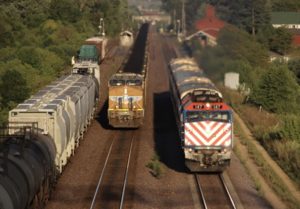By: Steve Sweeney
One of Trains’ sources of information on positive train control and signaling from 2016 to present has been materials from a University of Wisconsin-Madison Engineering Professional Development signaling basics course taught in Philadelphia.

Trains published an article on the course in June, but as the final deadline for a nationwide PTC rollout comes on Dec. 31, 2020, Trains reached out to UW instructors to learn what else has happened in the way they teach PTC.
Original instructors Bob MacDonald and Jim Hoelscher answered the call, as did Jim Balliet, who joined the instructing team more recently.
The following is an excerpt of Trains’ typed questions, and the UW instructors’ answers, edited where necessary for style or readability.
TRAINS:
Many of your students are not signal engineers. You have even said that these people are taking the course for better understanding when working with engineers and contractors. What questions have they been asking since 2016, and have those questions changed with time?
UW Instructors:
The students that attend this class have had a wide diversity in their technical knowledge and were eager to understand the basics of PTC based signaling. The training we have done to date was related to the explanation of fundamental technical design and operational expectations as well as the difficulties in meeting the goals of this undertaking. The questions of the prior classes are consistent with the nature of the class where they are in a learning mode with limited understanding of PTC systems. As these systems are now going on-line, we would expect the same student diversity being applied in the review of the PTC technical requirements and implementation, expectations and operational benefits that PTC can provide. Prior to the next class we will be reviewing the PTC portion of the training program. The changes will include material associated with the fundamentals of PTC including but not limited to:
1. A review of the challenges related to operating a mix of both vital and non-vital train control systems and how standards of vital system assurances are being maintained.
2. The tasks required in validating a systemwide level of safety that assures any risks associated with PTC implementation are manageable.
3. The process of implementing interoperability given the wide diversity of systems and users.
4. The potential for evolution of the rail industry given the transition to an integrated and communications-based PTC “system” is installed as the baseline technology.
TRN:
Do you see any convergence on signal system designs, hardware, or operating rules because of PTC? Put another way, are railroads looking to simplify signaling so interoperability is easier?
UW:
That remains to be seen although some evolution is underway. In most instances, PTC has established a major transition from a wayside centric and product oriented signaling control system to a multi-segment “system” oriented, more train centric control system. The impact on the signal system, equipment and operating rules will depend on the goals of the railroads in each rail segment (e.g., freight, commuter, high speed commuter). From the freight railroad perspective, one would expect that with increased intelligence onboard the train and the use of secure communications among the office, wayside and onboard, the operational and safety dependency previously placed on the pre-existing signaling system may be reduced. Freight railroads are already in the process of discontinuing cab signaling systems in some track lines.
Railroad Operating Rules have all been amended to reflect PTC and the more industry affiliated operating rules such as the General Code of Operating Rules (GCOR) used by class I railroads in the western U.S., have been evolving to incorporate PTC into the rule set. It is possible that continued innovation with regard to increased capability of train borne equipment and extended communications capabilities could eventually bridge the gap to more seamless interoperability between the freight and higher speed rail lines.
Positive train control is one of Trains’ Top 10 stories of 2020.
TRN:
Now that the PTC roll-out is complete, what changes for the industry? What do those non-engineers taking your course need to know now? Does the job change for men and women designing and maintaining these systems?
UW:
One of the biggest impacts to the industry and for those to operate and support PTC is the larger system scope. PTC as an integrated system, consists of primarily four technical segments of hardware and software. These are generally noted as office, communications, locomotive (or onboard) and wayside. Improving design and maintaining each of these segments, include the newly required recording and maintaining a geographical capture of the track lines into a database. This database (e.g., data consisting of grade, locations of equipment, civil limits, etc.) is used by the onboard system to manage train speeds and interact with the wayside. All of these areas require expertise not previously needed to support safe train operations and supplemental to the knowledge base used to maintain the existing signaling system. Training in the technical basis and fundamentals of each PTC system type and specific to each technical segment will be essential with respect to each of the four technical segments.
UW instructors’ opinions on PTC and the roll-out appears online.













